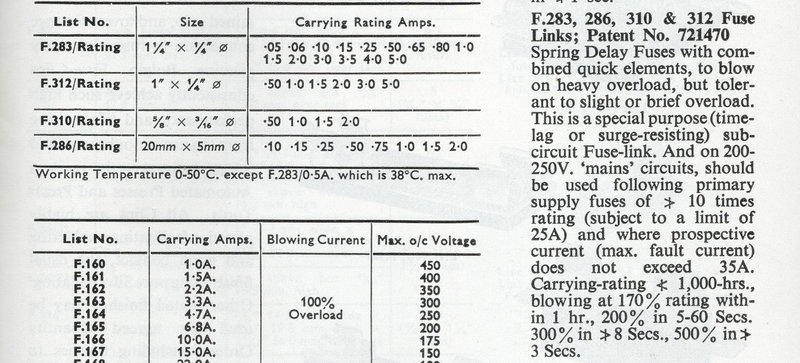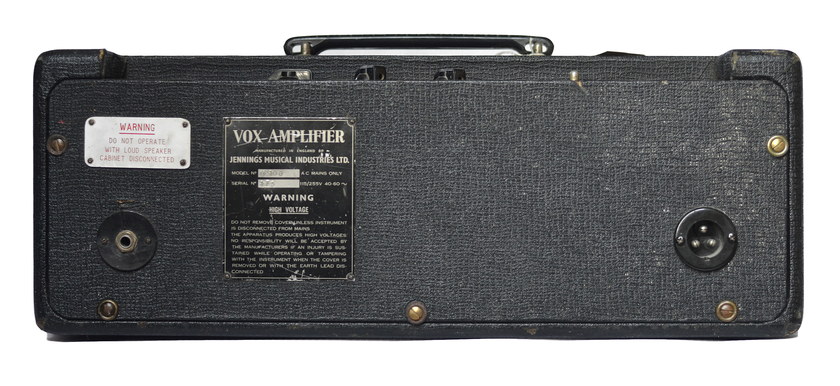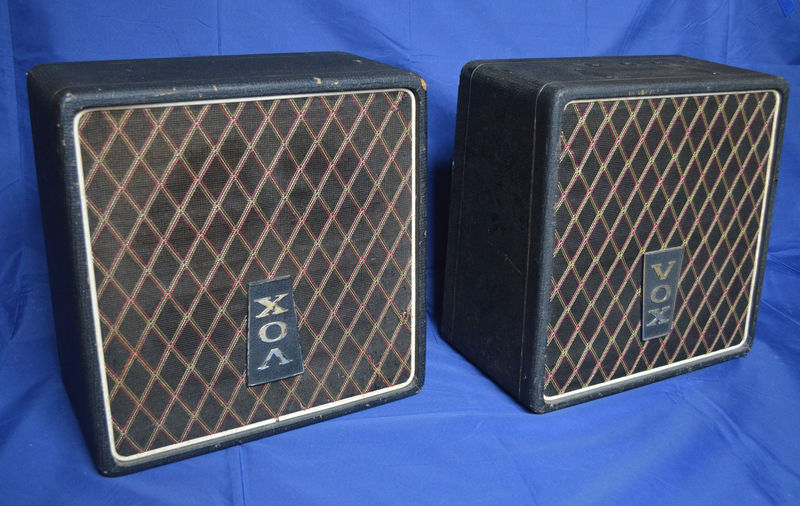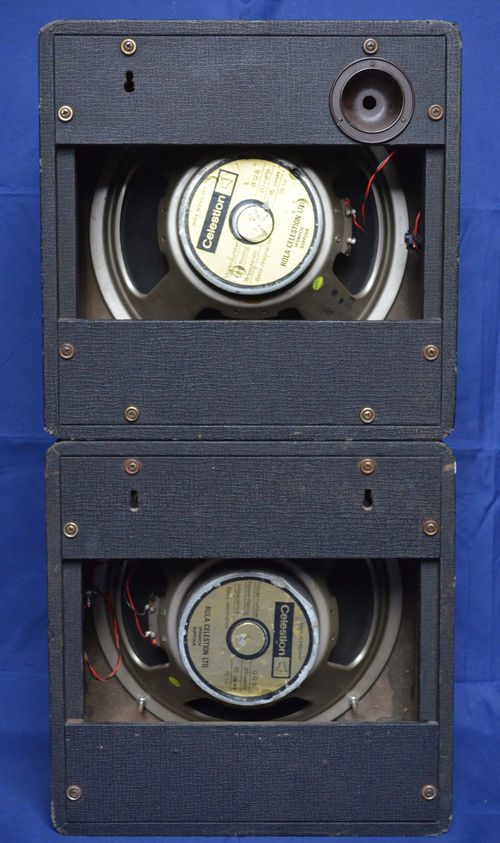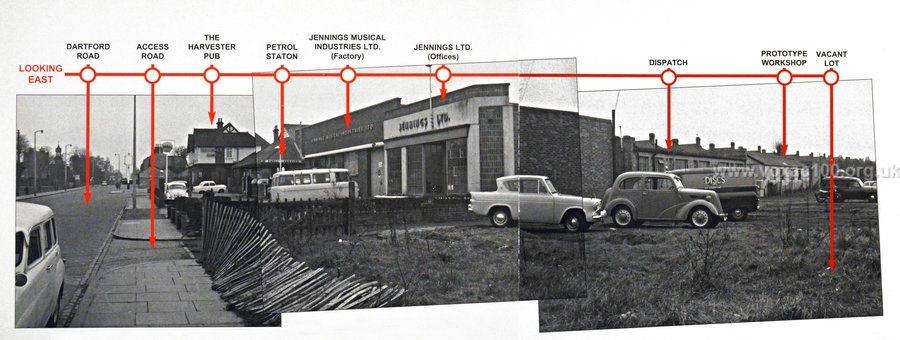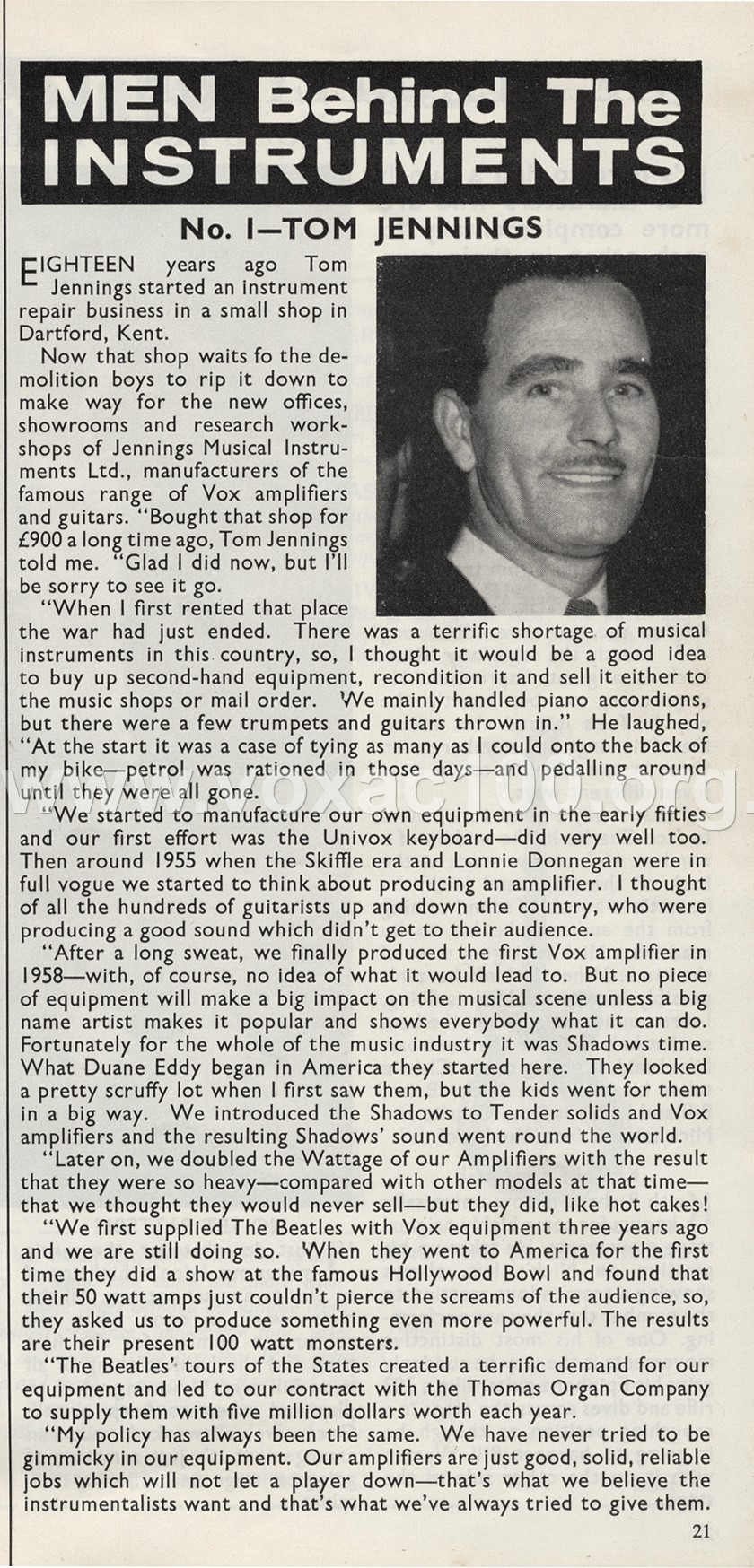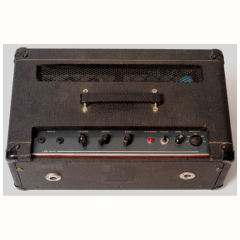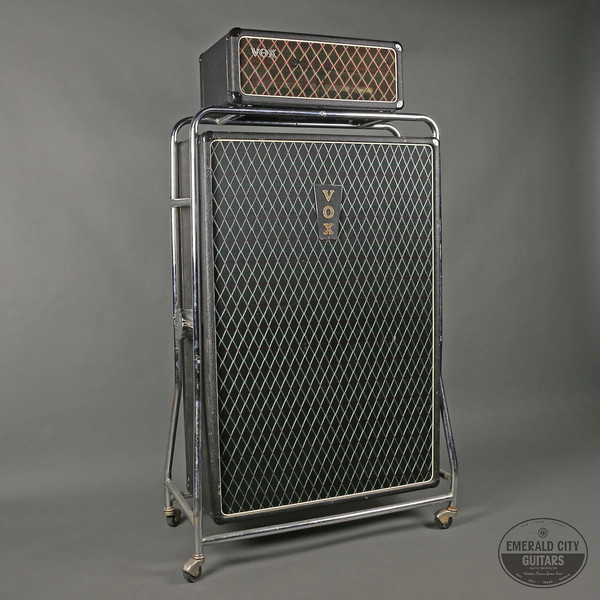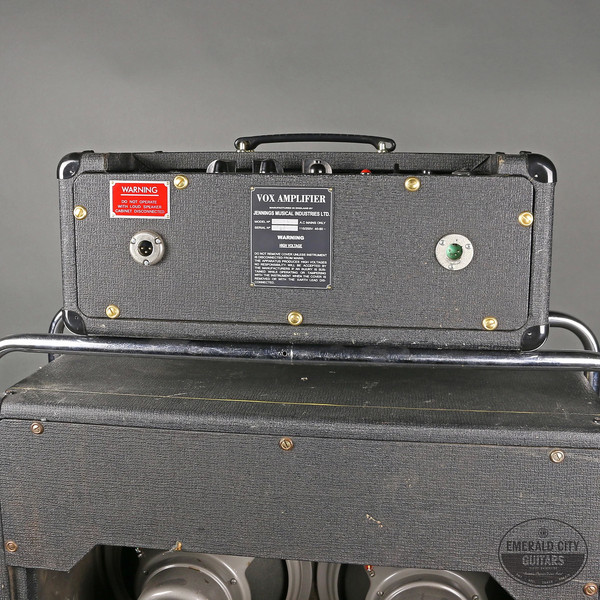VOX AC100 - UPDATES AND NEW INFO
Jan. to March 2020
28th March
Picking up from the end of yesterday's entry, some material on the creation in 1968 of the new Thomas Vox Service Center and Training Program, overseen by Donald John. Below, some pages from the booklet, which gives an overview of the programme and details of routine trouble-shooting procedure for organ maintenance.
The front page of the booklet (released in October 1968) and two specimen introductory pages - similar in many respects to a print-out of a powerpoint presentation.
A note in "Billboard" magazine, 10th August, 1968.
27th March
Some notes on Thomas Organ:
1950s and early 1960s: Thomas Organ was owned by Pacific Mercury Electronics. Pacific Mercury, which made the organs that Thomas sold, was based initially in Joplin, Missouri. The company officers were effectively those of Thomas Organ - Joe Benaron (President), Stan Cutler (Head of Engineering), Donald John (Head of Service Department), and so on.
Detail from "Yearbook of Radio and Television" (1963). Pacific by this time had set up its factory in Sepulveda (Van Nuys).
Latter part of 1963: Pacific Mercury and Thomas Organ were taken over by Warwick Electronics. Talks were reported as being in progress on 24th August '63 ("The Desert Sun" newspaper). At that time, Sears-Roebuck had a controlling interest in Warwick. Warwick's main business was making TVs and other consumer goods, mostly marketed under the Sears name.
Late 1963 / early 1964: The Warwick development department in Niles, Illinois, began working on designs for new organs for Thomas to sell. These were manufactured in the Pacific / Thomas factory in Sepulveda - Hayvenhurst Avenue.
Late August 1964: the "Million Dollar Deal" forged by Thomas Organ with JMI. In effect, the "Deal" was also with Warwick Electronics, whose name was at the head of at least one set of papers signed by Tom Jennings in 1965.
Tom Jennings with Warwick people in 1965.
Mid September 1964: Consignments of English-made Vox amplifiers and guitars began arriving in Chicago and Los Angeles (Van Nuys).
December 1964: The first Service Bulletin issued by Donald John for Vox amplifiers, including the AC100, imported by Thomas Organ.
Donald A. John had been part of the Pacific Mercury / Thomas team from at least 1963 (see the first entry above). He oversaw the expansion of the service department in 1968.
1966: A controlling interest in Warwick (and therefore Thomas Organ) was taken by the Whirlpool Corporation. Sears retained a large tranche of shares. The two owned 83% of Warwick in 1971.
24th March
Photos of Pete Townshend at home in 1967 - used as supports for two speaker cabinets, the upper sections of two AC100 trolleys.
Pictures from Alamy.
23rd March
Some details relevant to AC100s from a Bulgin components catalogue. First, the main internal fuseholder and 1A anti-surge (= "surge-resisting", "time-delay", or "slo-blo") fuse:
The internal fuseholder, mounted on the preamp chassis - Bulgin F50.
The "anti-surge" fuse, mounted at factory (ie by JMI) on the Bulgin fuse-holder illustrated above - a Bulgin F283, 1 1/4 inch, 1 amp. The fuse would allow transient peaks of current through but blow if there was continuous over-current flow.
21st March (2)
The entry for "Jennings Electronic Industries" in the "Purchaser's Guide to the Music Industries" (an American annual publication), issue for 1970. The entry for "Vox" relates solely to Thomas Organ, making special mention of the new "Voxton" line of guitars.
21st March
A grey panel AC100, serial number unknown, replaced handle and logo. The dings on the front edge of the box do not correspond with any amp already registered. Thanks to Phil for the picture.
20th March
A quick shot of three Vox wallets made and issued for use at Trade Fairs. They measure approx. 15 1/4 x 10 1/2 inches. From top to bottom: English c. 1964/1965; American late 1965/early 1966; American c. 1967.
13th March (2)
The page on the preamp of the AC80/100 with no control panel legends is now up. The interesting thing, which hadn't registered previously, is that the complement of yellow-print Mullard preamp valves is: two ECC83s and one ECC82 instead of two ECC82s and one ECC83. All three date from 1963: June and November.
From an electronic standpoint, an ECC83 as driver valve (V3) works perfectly well if balanced and of low noise. The result: more gain.
The presence of this unusual complement adds to the sense that the amp was used for testing. Was this one of the AC80/100s that JMI tested in the Burndept factory in Erith in July 1964? See the entry at the top of this page for more.
13th March
A set of picture pages of the AC80/100 with no legends on its control panel is in preparation. The first is available here.
28th February
Below, further pictures and details of the spare AC80/100 seen on the Beatles' first major North American tour, August-September 1964. The amp, when present on stage, is normally stationed beside Paul's bass cabinet.
The three main Ac80/100s used on this tour were new, having been consigned to the group by JMI in late July. The back panels were consistently arranged. Paul's had brown cloth to match his speaker cabinet. The other two, which George and John used interchangeably, had black cloth.
It is likely that the spare was Paul McCartney's first AC80/100, brown grille cloth, distinctive back panel, issued in late December 1963. The spare certainly looks to have brown (as mentioned before) in the picture taken at Toronto, 7th September, '64.
Hollywood Bowl, 23rd August, the amp tucked behind Paul's spare bass guitar.
Jackie DeShannon, opening for the Beatles at the Hollywood Bowl.
Hollywood Bowl, detail.
Milwaukee, 4th September, 1964.
Toronto, 7th September, 1964.
Cleveland, 15th September, 1964.
Adelaide, 12th June, 1964. Paul's first amp - serial number 150B.
27th February
Some great pics of the Beatles, Maple Leaf Gardens, Toronto, 7th September, 1964:
John's amp from rear of stage.
John's amp front of stage.
Detail of John's amp during the press conference.
Paul's amp.
Paul's amp (his second brown-fronted AC80/100) and speaker cabinet - cabinet issued in December 1963, trolley in spring 1964.
24th February
This morning, looking at the back panel of the newly emerged AC80/100 in raking light revealed the original JMI screw holes for the serial number plate. They are pretty much impossible to see square on.
The holes are 3 1/4" x 4" apart. The back panel was originally arranged much as that of serial number 173.
See yesterday's entry for a full view of the back.
Serial number 173.
23rd February (2)
Below, the back panel of the recent AC80/100. The Bulgin mains connector (and the hole it sits in) is probably original. The holes for the present speaker connectors are a little rough.
When JMI provided pairs of connectors on back panels, they were normally carefully aligned. It seems likely that this amp originally had only one, probably the one at left.
The screws that left holes in the centre of the panel secured, at one time, a "something or other" measuring around 2" high and 3 1/4" wide.
Most JMI serial number plates are 3 1/4" wide - but 4" tall. No tell-tale screw holes are visible elsewhere on the panel.
The fixing point centre on the top edge of the back panel is a later addition. The other five have the imprint of the cup washers.
The page on known early AC80/100 back panels is here.
23rd February
The preamp of the new AC80/100. Only three changes, probably in the 1970s - two preamp filter caps replaced with grey Radiospares, and a replaced resistor:
21st February
A few more details, continuing yesterday's entry, on the early AC80/100 recently surfaced. At one point the rear of the box was painted in blue - removed around twelve years ago without too much harm to the black vinyl. The colour remains on the inner face of the back panel and in places inside the box.
The original black grille cloth, the remains of which are visible in one of the pics below, was removed at that time and the present cloth added.
The date code on the volume pot - photographed in a dentist's mirror and then reversed - is "LK" = December 1963.
It looks as though the Woden part numbers and date codes were deliberately rubbed off the green tranformer shrouds at some point.
The control panel is properly punched and produced. Its underside is bare aluminium. In all respects the panel is identical to those on other AC80/100s - except for the fact that it never had legends of any sort.
The full legend on the pot, which is made by Egen, is "1/2 MEG LOG LK. For more on Egen, see this page.
One of the yellow-print Mullard EL34s - XF2, date code "B3F3" (July 1963).
The power section. Components all original apart from the plate resistors, which are now on flying leads from the the OT primary. The originals evidently flamed out, damaging the tagboard - not the first AC80/100 in which this happened. Date codes on the Welwyn 270R bias resistors and 470R screen resistors are "VA" = January 1964. Date codes on the Dubilier 100uf cathode bypass caps are "UK" = October 1963.
20th February
Some preliminary notes on the AC80/100 in a thin-edged box that came to light recently, pictured below:
The chassis has the usual run of component date codes: Dubilier capacitors "UH", "UK" and "UM" = August, October and December 1963; Welwyn cement resistors are all so far as can be seen "VA" = January 1964. Pot codes are not known at present.
Two of what appear to be the original Mullard yellow print EL34s remain - date codes B3F3 = produced at the Blackburn Factory, 1963, third week of July. There was often a considerable gap between production and use.
On its inside face, the baffle has the remains of black Vox cloth - likely to be original. That places the amp in or after July 1964. John and George were the first to have black-cloth amps - in July 1964 - see the entry at the top of this page. Thereafter the rule seems to have been that black-fronted amps went with guitar speaker cabinets (SDLs also in black) and amps in brown went with bass cabinets. All AC80/100s up to July 1964 had brown.
The amp is not a prototype or pre-production model.
Inside the cabinet a single writer wrote in yellow chalk: "2/11/62. AC100. For Demonstration Purposes Only". These chalkings were probably written in the 1980s or 1990s to give the amp a sort of history or to "explain" it. The date is so massively impossible as to invalidate the rest, unfortunately.
However, it may nonetheless be that the AC80/100 was a demonstration or test unit. The Woden transformers have no part numbers or date codes printed on them, and the control panel has no legends. The lack of legends probably counts against its being a demonstration unit in a sales environment - ie. at a Trade Fair.
Further pictures to follow.
12th February (3)
A picture page on the preamp of the hybrid 100 watt PA amplifier is now available here. A similar page on the power amp will follow soon.
12th February (2)
A note on Mullard ECC83/12AX7 preamp valves branded "VOX". These do not appear to have been fitted at factory to amplifiers made in England. Indications are that they were a special order by Thomas Organ for repair centres in the USA.
Most surviving examples have date codes for the second half of 1965 and early 1966. The one pictured below has "B5G2" = Blackburn factory, 1965, 2nd week of July (not August as stated initially).
The Thomas Organ part numbers for "English" valves were: ECC82/12AU7 = 09-5206-0; ECC83/12AX7 = 09-5012-0; and EL34/6CA7 = 09-5610-0. The number on the examples below - 1022-551 - is presumably either the Mullard code for the Thomas order, or a Thomas sub-code.
The code on valves from 1966 is: 1022-623.
Although no examples of "VOX" branded EC82/12AU7s have come to light so far, it seems likely or at least possible that some were produced. Early replacement EL34s were normally "General Electric" branded Mullard XF2s. Early replacement ECC83s appear for the most part to have been "General Electric" branded Mullards too.
12th February
Some pages coming soon on one of the Vox 100W PA hybrids - solid state preamp, valve power amp (4 x EL34). The preamp section is pictured below. Potentiometer date codes are "AO" = January 1967.
An overview of the various types of all-valve and part-valve Vox PA 100 can be found on this page.
The five microphone channel boards in the amp in view have one AC107 germanium transistor each. The hi-impedance channel has a Mullard OC45 (germanium) and a BC108 (silicon). The mixer board - volume, treble and bass - has one AC107 and one OC45. The original meter was replaced at some point by a later one.
10th February
Some pictures of serial number 182 taken in 2005 prior to the restoration of the box, seen immediately below. At some point (in the 1980s?) the amp was converted to fixed bias. Thanks to Martin for the pictures.
7th February
Tom Jennings and company at the "Associated Musical Instrument Industries" Fair, Russell Hotel, London, 16th-20th August, 1970. Jennings Electronic Industries had stand 162 at the Fair. "Vox Sound Limited", recently saved from oblivion, had stands 114-116. On VSL, see this page on the Vox Supreme website.
"Music Business Weekly", 29th August, 1970. Note the "Jennings News" sheet
4th February
AC100 serial no. 2111 is currently for sale here, along with a Super Foundation Bass cab. The amp conforms to schematic OS/167 - doubled up main filter capacitors, and an ECC83 rather than an ECC82 at V3. Although documentation is lacking, it could be that amp and cab left the factory together in late 1967.
1st February
The page on Vox in 1967 and 1968 has been updated - as ever, further material to be added. In recent searches in the British Library for contemporary comment and documents, one of the things that came up was a picture (below) of Eric Summer, chairman of the Royston Group of Companies.
As mentioned a few days ago, Royston took a controlling interest in JMI in late 1962, and the fortunes of the two to a large degree became intertwined thereafter. Unfortunately the profits made by subsiduaries were channelled by Royston, presided over by Summer, into projects that ultimately failed - the largest being the development of "Midas", the black box flight recorder. When Royston collapsed in 1967, the companies it held were brought down too, Jennings included.
One could be harsh and point to Summer as the man who ruined Tom Jennings. But where boards and corporate governance are concerned, it was obviously more complex than that.
A small rough print picture from the "Board of Trade Journal", vol. 191, no. 3615, 1st July, 1966. Eric Summer, chairman of Royston, sitting, centre.
31st January
Entry corrected 7th January 2023. There is now a page on Heslop on the Vox AC30 website.
A small correction to the note about Heslop and Co. below. Royston had actually brought Heslop under its wing in 1958 [corrected from "by 1961"], ie. five years before the acquistion Jennings. Heslop is likely nonetheless to have ended up working more for JMI than any other member of the Royston Group. Burndept's products were by and large marketed in metal enclosures.
Heslop was registered as a company in London ( NOT "Newcastle-upon-Tyne" as previously stated). There was a works in Rayleigh, Essex.
26th January
A pair of Vox 12 inch speaker units from 1967, logos of the normal "solid state" type.
They were designed for use in clubs, halls, churches, factories, and so on - general public address purposes, including temporary installations. A couple of nails (for wall mounting if needed), some lengths of cable, and bob's your uncle. Thomas Organ only marketed a 10 inch unit in the USA.
The speakers below are a sort of inverse of each other - one arranged to point upwards, the other down. The original silver alnicos (T1088s) were cashed in at some point by a former owner.
The cabinets were probably made by Heslop and Co., based in Essex and a fellow member of the Royston Group. Indeed, it seems as though Royston acquired Heslop expressly to provide wood-working services to JMI.
Jennings pricelist of April 1967.
25th January
"Wireless World", April 1968 - a supplement on microphones, listing the three that JMI sold as "VOX" in the late 60s, though they were in actual fact made by Reslo.
The prices quoted correspond with the ones given in the pricelist of April 1967.
Relevant sections from the Vox retail pricelist, April 1967
Just to add that in April 1968, JMI will have been in the process of winding up - as noted below (entry for 26th December), the company's goods were auctioned in lots in September 1968, one set at Dartford Road, the other at Erith.
It's interesting to see that the company is termed (presumably by the official receiver) "Jennings Musical Instruments Limited" rather than "Jennings Musical Industries" in the final winding up sales. "Jennings Musical Instruments Limited" was the original name of Tom Jennings's business in the 1950s, and it looks as though this incarnation of JMI owned the other, along with "Vox Sound Equipment Limited".
"Practical Wireless" magazine, September 1968.
24th January
Some notes on the Jennings buildings at 115-119 Dartford Road. Number 115 was the Works; number 117 served as storage/repair; number 119, the only building that now survives, Research and Development, and prior to that the shop/showroom.
During the course of 1964, the AC100 chassis assembled by Westrex were transported to Dartford Road and made ready for sale at number 115 - given boxes and back panels, serial numbers, and so on.
Below, a detail from the Ordnance Survey map of Dartford, surveyed in 1960 and published in 1962. House and building numbers are marked.
The shed (workshop) behind number 115 belonged to Jennings, so too the one behind number 119 (Artists' Loan equipment). The complex was taken over in late 1968 by "Jennings Electronic Developments", the company formed by Tom Jennings after the demise of JMI. Number 119 was taken over by Alan Pyne c. 1975 when Jennings's new company folded.
Numbers 115-119 Dartford Road, marked on Ordnance Survey sheet TQ5274-TQ5374A, part of a series produced to aid the National Grid - scale 1:2500.
Composite Panorama of the Works published by Jim Elyea, Vox Amplifiers: The JMI Years, pp. 544-545. Note that number 115 encompasses the factory and the offices (with a lower roof-line). Numbers 117 and 119 are out of picture.
Below, a report in the "Electrical Times", 22nd October, 1964, giving a small glimpse of moves to expand and reconfigure operations following the "Million Dollar Deal" .
"Electrical Times", vol. 146, no. 17, 22nd October, 1964.
The greatest change, however, was the expansion into the West Street Works in Erith. Production of AC50s and AC100s began there in early Spring 1965.
23rd January
A couple of magazine pieces on Tom Jennings, the first from "Time and Tide", 15th-21st April, 1965, the second, perhaps better known, from "Beat Instrumental" magazine, November 1964.
Some interesting details in "Time and Tide": JMI had around 170 employees in early 1965; 50% of its output went to the States (the "Million Dollar Deal"); Tom's office, where the interview was presumably held, was small and dark brown; and he had a great fear of seeing Vox equipment breaking down on TV.
"Time and Tide" magazine, April 1965.
"Beat Instrumental" magazine, November 1964.
Interesting too to see Jennings' comment on the acquisition of JMI by Royston Industries in 1962.
"The Guardian", 30th Jan., 1963. This appears to be the earliest report in an English newspaper. The deal was evidently done some time before this note was printed though.
17th January
A note on the AC100 currently on Reverb (on consignment with Emerald City Guitars). The head - a serial number somewhere in the 700s - came up alone some years ago without serial number plate or warning plaque. See the pictures immediately below - more here. Repros have evidently been supplied in the meantime, along with new back panel screws. The cab, which comes from some other source, has a Thomas Organ Super Beatle trolley.
The amp, sold on ebay some time ago. Note the position of the hole in the grille cloth.
The speaker cab, which is certainly English, has four alnico T1088s. Some if not all of the wiring loom is original. The grille cloth has been renewed.
15th January
Thanks to Martin Kelly, pictures of the Thomas Organ Vox Pocket Reference Guide from late 1965 / early 1966 are now available here.
13th January (2)
Just to signal that there are two AC100s on sale at the moment: - serial number 498, an early "100 Watt Amplifier" (fixed bias), summer 1965; and serial number 813, a Mark 2 (fixed bias with brimistor), last quarter of 1965.
13th January
A rough and ready detail from the JMI amplifiers flyer of September 1964. Note that the AC100 is represented in a thick-edged cabinet with corner protectors, as it also is in an advert placed in "Melody Maker", 12th Sept., '64
The date is given in the runner immediately above: "9.64".
6th January
"Dartford and Swanley Chronicle and Kentish Times", 19th February, 1965. A press view at Dartford Road on 9th February in advance of the display at the Frankfurt Fair (Musikmesse), March '65.
Tom Jennings (right) with Ray Pyman (centre), and three other members of JMI staff (to be identified in a later post). An AC100 SDL can be seen far right; centre the Guitar-Organ and Vox Continental.
The article accompanying the photo - there is another piece next to it on Tom Jennings himself.
Below, two pictures of the Vox stand at Frankfurt, March '65. Some sources - both published and on the web - state that the shots are from the show the year before (in March 1964). This is not so. Note the presence of the large box AC50 (mid 1964), and the AC100 SDL, which was new for the Beatles in early August 1964.
Frankfurt, March 1965. The AC100 SDL "The New Beatles Model" at left, the large box AC50 in the centre. Underneath the second guitar from left, one can just make out the meter and some of the controls of one of the new Vox PA amplifiers
6th January
"Dartford and Swanley Chronicle and Kentish Times", 10th December, 1965 - the top floor of the West Street Works (Erith) damaged by fire, equipment on other floors by water. Reg Clark noted that operations were quickly moved to Burndept's Riverside Building (picture below).
"Dartford and Swanley Chronicle and Kentish Times", 10th December, 1965.
West Street Works ablaze.
The Burndept Riverside Works, temporary home to Vox in early 1966.
The position of the West Street Works indicated by the yellow arrow, the Riverside Building by the white.















